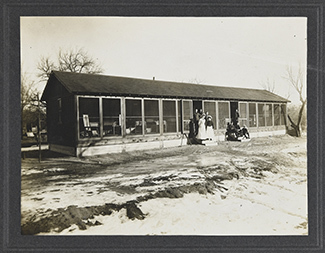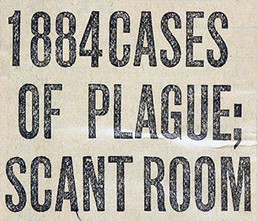‘No respector of persons’ – Michigan’s fight against tuberculosis
By LESLIE S. EDWARDS
Michigan Department of Natural Resources
Archivists at the Michigan Department of Natural Resources’ Michigan History Center process and preserve state and local government records. While processing public records from offices like the Department of Public Health (now the Department of Health and Human Services), staff members often uncover fascinating stories from our state’s past.
The following article chronicles the state’s response to the tuberculosis public health crisis in the late 1800s and early 1900s. It is adapted from a longer article originally published in TRACE, the Archives of Michigan’s official magazine. TRACE is available digitally and in print for free to members of the Michigan History Center.

Don’t spit. Wash your hands. Don’t share drinking cups. Turn your head away when you cough. These were recommendations made by Michigan public health officials to alleviate the spread of pulmonary tuberculosis at the turn of the 20th century.
In 1882, German scientist Robert Koch announced his discovery that tuberculosis was not hereditary, as scientists and medical practitioners had believed. Instead, he claimed it was an infectious, airborne disease that could be spread by coughing, sneezing, spitting, talking and singing.
In Michigan, Dr. Henry Brooks Baker had drawn this same conclusion nearly a decade earlier. He faced the same challenge as Koch: How was he to convince the public that basic health measures could contain the spread of the disease?
Michigan’s early response
As a Civil War hospital steward, assistant surgeon and medical officer, Dr. Baker knew that an organized approach to sanitation could reduce deaths from disease. He was instrumental in the formation of the State Board of Health, which was established by Public Act 81 in July 1873. As the board’s first secretary, Baker collected and analyzed information about diseases, including tuberculosis, or TB.
Baker guided the State Board of Health’s first educational campaign about TB in the early 1890s. It held sanitary conventions across the state and published a leaflet that outlined how tuberculosis spread and how it could be prevented.
The leaflet encouraged sanitary measures including disinfecting rooms with burning sulfur, boiling handkerchiefs and separately washing the clothing of people infected with TB. It encouraged isolating sick people from those who didn’t have the disease.
In 1893, the board took a historic step and publicly declared tuberculosis a communicable disease. Michigan became the first state in the country to require the reporting of tuberculosis.
|

The board’s reach and influence lacked authority without backing by Michigan law. In 1895, 22 years after the board was established, the Michigan Legislature passed Public Act 146, an education bill that required public schools to teach children how tuberculosis spread and could be prevented.
As part of the act, the State Board of Health made recommendations to school boards on how to sanitize schools. Measures included wiping off desks and chairs with a clean, damp cloth, discontinuing the use of slates and shared books, sprinkling school room floors with water before sweeping to alleviate dust, and airing out all school rooms before use. Spitting on the floor (yes, common at the time!) was strictly prohibited, and school rooms needed to be thoroughly disinfected at least once a year.
Local governments join the fight
Local municipalities and organizations also took up the fight against the “great white plague.” Grand Rapids developed a community-wide educational campaign in 1897 and, in 1905, established Michigan’s first anti-tuberculosis association. The city of Detroit soon followed, and in 1907, the Upper Peninsula Association for the Prevention and Cure of Infectious and Contagious Diseases was organized with representation from 10 counties.
By 1917, Michigan had three TB hospitals, six county sanitoriums and 21 anti-tuberculosis associations. These associations worked as the volunteer action arm of the State Board of Health, implementing various educational campaigns. Children learned how to keep their face, hands and fingernails clean, cover their coughs and sneezes, and play outdoors in the fresh air. Women and girls abandoned dresses and skirts that reached the ground, as they were major carriers of TB bacteria found on floors, sidewalks and streets.
In 1901, local health officials mandated that spittoons for chewing tobacco found in hotels, saloons and other public buildings should contain disinfectant to help control contamination. Several cities put anti-spitting ordinances in place, including Kalamazoo (1904), Grand Rapids (1905), Detroit (1906), Holland (1908) and Saginaw (1910).
Michigan’s joins the national effort
In 1905, Dr. Baker retired after 32 years of public health service. Around that time, tuberculosis prevention efforts also ramped up on a national level. In 1904, the National Tuberculosis Association was formed, followed four years later by Michigan’s statewide TB association. Originally named the Michigan State Association for the Prevention and Relief of Tuberculosis, it eventually became the Michigan Tuberculosis Association.
|

|

The MTA laid out an action plan to engage and educate the public through literature, lectures, publicity, a traveling exhibit and an annual convention using the motto: “the weapon against tuberculosis is education.” Still, some teachers refused to teach prevention, saying “the more you think of the disease, the more there is of it.”
The MTA joined with the State Board of Health to advocate for legislation to help prevent TB. Known as the “tuberculosis law,” Public Act 27 of 1909 required all physicians to report every case to their local public health officer within 24 hours. In turn, the public health officers reported cases quarterly to the State Board of Health.
Women’s organizations also partnered in the fight against TB, particularly after the formation of the MTA. The Michigan Federation of Women’s Clubs cooperated with local physicians and medical officers. They promoted medical inspections in schools, assisted with anti-tuberculosis clinics and secured metal anti-spitting signs for public places.
Under the direction of the National TB Association and local anti-tuberculosis associations, women’s clubs across the state participated in the national health movement called the “Modern Health Crusade.” This program taught children the importance of good hygiene in a fun way, awarding them with certificates, buttons and pins.
In 1915, the State Board of Health’s Dr. William DeKleine mounted another statewide effort that built upon Baker’s original survey on diseases. Called the “Health First” campaign, it brought together a team of more than 15 professionals who conducted a two-year TB study, visiting 70 of Michigan’s 83 counties. Three weeks were spent in each county. Visiting nurses spoke with health professionals, women’s clubs and anti-TB societies and arranged for home visits to people suspected of being infected.
Concurrently, a publicity agent worked with local newspapers to engage community leaders in distributing educational materials. Visiting nurses and local doctors also provided free TB clinics and educational lectures given at various venues throughout each county. The Battle Creek Enquirer reported that “the best thing the tuberculosis survey is doing is to awaken an interest in the prevention of the disease.”
One of the board’s public health messages in 1917 was simple: tuberculosis does not discriminate. They stated that TB was “no respector of persons. No country, no race, no sex, no color is immune to tuberculosis.”
By the late 1940s, the discovery of an antibiotic that was effective in killing TB changed the threat of the disease – and the state’s response. While still a health risk today, the threat tuberculosis poses to public health is greatly reduced. Over time, the state has turned its communications focus to other diseases, including influenza in 1918 and COVID-19 today.
For more unique stories the Michigan History Center staff has uncovered through its collections and research, visit the MHC’s companion website Michiganology.org.
|
Check out previous Showcasing the DNR stories in our archive at Michigan.gov/DNRStories. To subscribe to upcoming Showcasing articles, sign up for free email delivery at Michigan.gov/DNR.
/Note to editors: Contact: John Pepin, Showcasing the DNR series editor, 906-226-1352. Accompanying photos and a text-only version of this story are available below for download. Caption information follows. Credit Michigan Department of Natural Resources, unless otherwise noted.
Text-only version - Michigan and tuberculosis
Automobile: The Michigan Tuberculosis Association toured the state with its Health Education Car, pictured here around 1926. Credit: Archives of Michigan
Cartoon: Illustrator Fred Wheaton’s political cartoon showing how risky behaviors lead to TB deaths was published in the State Board of Health's journal Public Health in July 1917. Credit: Archives of Michigan
Headline: A headline in The Detroit Times on June 14, 1918 reported that the number of cases of tuberculosis placed pressure on Detroit's inadequate hospital facilities. Credit: Archives of Michigan
Pamphlet: In 1908, the State Board of Health released this educational pamphlet, which referred to tuberculosis as “The Great White Plague.” Credit: Archives of Michigan
Poster: This detail of a Michigan Tuberculosis Association poster from around 1942 illustrates how TB germs are spread. Credit: Archives of Michigan
Sanitorium: Because fresh air, even in winter, was considered a key treatment for TB, patients at the Grand Rapids Municipal Sanitorium in 1908 stayed in cabin-like buildings with large screened-in porches. Credit: Archives of Michigan/
|